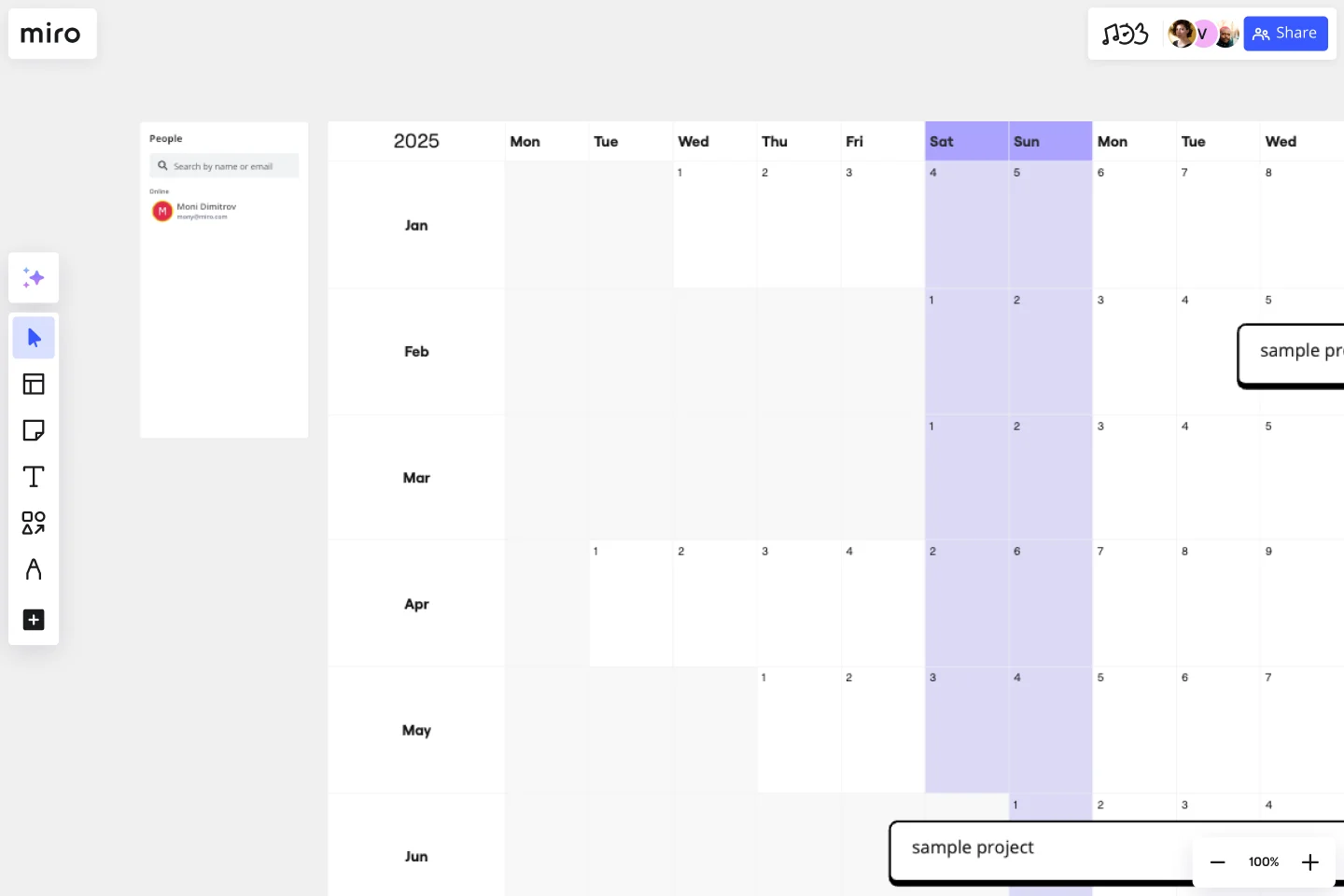Project Timeline Template
Use the project timeline template to translate complex details into visual clarity and ensure smooth project progression.
About the Project Timeline Template
The project timeline template streamlines the planning and execution of tasks, ensuring stakeholders remain informed, on track, and aligned with the project's objectives. As teams evolve and businesses expand, a comprehensive timeline becomes pivotal to managing complex projects with varying dependencies.
This project timeline template consists of a calendar containing tasks, milestones, and deliverables. It provides an overview of what needs to be done, by when, and in what order, allowing teams to visually understand the flow and dependencies of individual tasks within a project's lifecycle.
How to use the project timeline template
Using the template is straightforward. Edit the timeline with just a few clicks to reflect project-specific details. Here is a step-by-step guide on how to use the project timeline:
Step 1. Add project details
Click on any calendar cell to add your project info. Add the tasks or milestones as needed.
Step 2. Expand as required
Should your project span a more extended period or contain more details, you can quickly expand the template. Click and drag the edges to add new rows to the calendar.
Step 3. Incorporate additional artifacts
If you need to reference other items or details, drag and drop files directly onto your board, adjacent to or within the timeline, for an integrated view.
Step 4. Adjust and refine
Periodically revisit the calendar as the project progresses. Adjust as necessary, reflecting any project scope or timeline changes.
Step 5. Save and share
Save your changes once you’re happy with your timeline's details and layout. You can then share the board link with team members or stakeholders for collaborative viewing and editing.
Why should you use a project timeline template?
Clarity and visualization: The template translates complex project details into a digestible format, enabling team members to quickly grasp the project's scope and timeline.
Improved collaboration: Providing a single source of truth ensures that all team members are aligned, reducing miscommunication and ensuring everyone is on the same page.
Efficient resource allocation: Teams can foresee when peak workloads might occur, allowing for better resource distribution and prevent bottlenecks.
Tracking and accountability: An updated project timeline template serves as a reference point for progress tracking, helping to hold team members accountable for their responsibilities.
Flexibility in planning: When unexpected changes occur, teams can adjust timelines, ensuring the project remains on course while accommodating unforeseen obstacles.
Discover more project charter templates to simplify your planning.
Can I customize the template to fit longer-term projects?
The template is designed to be flexible, allowing you to adjust it to accommodate projects of any length.
Can the timeline be integrated with other tools or platforms?
While this specific template is designed for use on a board, it's structured in a way that allows for smooth integration with most project management tools, include Jira cards and Google Workspace.
How can I share the timeline with stakeholders who don't have access to the board?
You can export the timeline as an image or PDF, ensuring stakeholders remain informed, even if they don't have direct access.
Get started with this template right now.
Product Voice Design toolkit
Works best for:
Product Management, Planning
The Product Voice Design toolkit facilitates the development of consistent and impactful product messaging. By defining brand voice attributes, tone guidelines, and messaging principles, this toolkit ensures that product communication resonates with target audiences. With sections for crafting messaging frameworks, storytelling templates, and content guidelines, it empowers product teams to create compelling and cohesive product narratives. This toolkit serves as a valuable resource for enhancing product communication strategies and building strong brand identities.
ERD Blogging System Template
Works best for:
ERD
The ERD Blogging System template in Miro efficiently manages and organizes digital content. It features key entities such as User, Post, Comment, Category, Tag, and File, which are essential for managing the creation and publication of blog posts, engaging users through comments, and organizing content via categories and tags. Additionally, it supports media attachments through the File entity, linking them to the relevant content. This template helps streamline the blogging process, making it an invaluable tool for content management and publication.
Fishbone Diagram for Healthcare
Works best for:
Fishbone Diagram
Ensuring high-quality care in healthcare settings requires a thorough understanding of root causes behind issues. The Fishbone Diagram for Healthcare template helps you analyze potential causes of problems in areas like patient care, staff performance, and administrative processes. This structured approach facilitates comprehensive analysis and collaborative problem-solving, ultimately leading to improved healthcare outcomes and patient satisfaction.
Balanced Scorecard Template
Works best for:
Operations, Strategic Planning, Project Planning
Balanced scorecards are useful tools for understanding business performance at a glance with regard to customers, employees, business processes, and financial progress. Learn more about BSCs and create your own using Miro’s Balanced Scorecard template.
Agile Product Roadmap
Works best for:
Roadmap, Planning, Mapping
The Agile Product Roadmap template enables teams to visualize and communicate the strategic direction of their product development in an agile environment. It allows for flexibility and adaptation to changing requirements while providing a clear overview of priorities and timelines. By incorporating feedback loops and iterative planning, teams can ensure alignment with stakeholder expectations and deliver value incrementally.
The Tiered Pricing Canvas - Product Plans
Works best for:
Product Management, Planning
The Tiered Pricing Canvas - Product Plans template helps product managers design tiered pricing strategies effectively. By mapping out pricing tiers, features, and value propositions, this template enables teams to optimize pricing models and maximize revenue. With sections for analyzing customer segments and competitive pricing, it supports data-driven pricing decisions. This template serves as a guide for crafting compelling pricing plans that align with customer needs and market dynamics, driving profitability and customer satisfaction.
